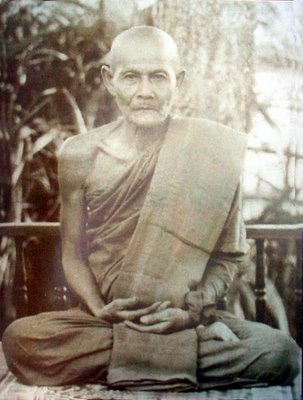Saturday, February 25, 2006
Knitting & Buddhist Meditation
As you know, I took up knitting partly because it seemed possible to use it for meditation practice. What is meditation? I think it means different things to different individuals. It can be a tool for relaxation, for energy, for supernormal abilities, etc. What about Buddhist meditation? The goal of Buddhist practice is to end Dukkha, which means to end suffering and stress. So the meditation is used for that goal.
There is a famous story of Hui Neng, the Sixth Patriarch of Ch'an Buddhist School in China. At one time there were two monks arguing about a flag flapping in the wind. One said, "the flag is moving." The other said, "the wind is moving." Hui Neng told them, "your minds are moving."
Many people would argue that the flag is actually moving, the wind is actually moving. True, these are phenomenon that are real and readily observed. But in regards to meditation, the practice of ending suffering and stress, the focus is on the mind level.
Let's say that a flag is flapping in the next town. Does the thought, "flag is flapping", enter your mind? Even when we walk by one we are sometimes ignorant of it. How about when a stranger falls ill? Do you feel the same level of anxiety as you do if someone close to you falls ill? So I think we can agree that things matter only when they enter our mind.
According to what the Buddha taught, we can put our reactions to what we experience in 3 categories. Like, dislike and neutral. Like results in desire, greed, etc. Dislike results in aversion, anger, etc. Neutral is just neutral. Most obvious stresses happen here. Basically we are stressed when we are separated from what we like, stressed when we are associated with what we dislike. Again, these are just the obvious. There are subtle stresses that we don't see right away.
It is the goal of Buddhist practice to see these mind activities clearly through meditation. We want to observe each and every moment thoroughly and ask ourselves if there's suffering and stress in what occurs in our mind. Through practice and time, we will be able stop the activities that cause Dukkha because we see everything clearly as they are.
Buddhist meditation include two major activities, concentration and contemplation. Concentration practice devlops calm and focus, which helps contemplation. Contemplation develops insights and wisdom, which also increases concentration. They are practiced in tandem. Both very important.
Knitting can be used to do concentration. I think this is quite obvious to see. Focus on each stitch as you knit. Not letting your mind wander off into the future. Not hurrying to finish a project. Not thinking about the what's next. Just concentrate on making each stitch. It is what it is. No agitated mind can make the project go any faster. Stitches will not magically appear. Why not be calm and just be. If you want, you can repeat your favorite knitting mantra in your mind while you go through the motion of making a stitch. You see, not only will you be practicing concentration, calming your mind, you will less likely to make mistakes!
Knitting can be used to contemplate Kamma (Karma in Sanskrit). When you cast-on, you are performing an action that will bring certain effect. Cause and effect. With each stitch you make, you are either ensuring the result that you desire will come, or going a different direction by changing the pattern, or laying down the foundation for disaster by making a mistake. It reflects how life works.
One can probably come up with a few more contemplation themes for knitting. But I think you got the idea. This is how I see knitting can be used for Buddhist practice. If you would like to read more, here's a short article on meditation practice, 'Steps Along the Path'.
Subscribe to:
Post Comments (Atom)


1 comment:
I'm so glad that you wrote about this. I've also given a lot of thought to this. I like your ideas a lot.
Post a Comment